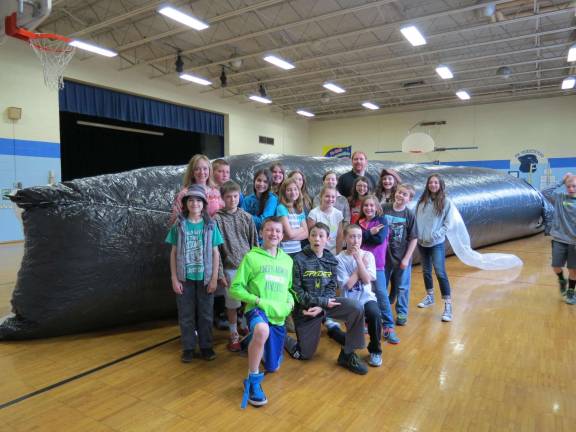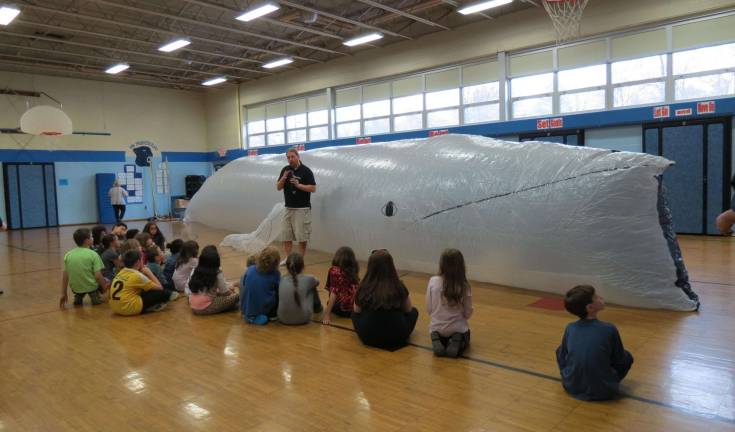Sharks at the shore? How about a whale at PK


BY PATRICIA KELLER
OAK RIDGE — Students at Paradise Knoll School in Oak Ridge were treated to attend a simulated “whale watch” inside their very own school this spring.
The presentation was by special guest Keith Bradley, brother-in-law of PK PTA Corresponding Secretary Debi Santa Lucia. Bradley teaches marine science in a middle school in Massachusetts but he brought his 60-foot replica of a humpback whale to New Jersey for the second time in three years at the request of his young niece, Tiffany, who attends third grade at the school. Bradley provided this cultural arts presentation to the school as a gift to his niece.
In 2010, and with the help of a fellow teacher, Bradley spent 14 hours over a February vacation constructing the whale he calls Henry - using only plastic sheeting, packing tape and a booklet with instructions on how to put it together. Bradley said the goal of the project was to expose his students to the inner workings of a whale. He said that witnessing the reaction of students as they see it for the first time makes the hours spent working on the project well worth it.
Bradley said in a 2012 interview with the Messenger:
“A lot of the kids have never seen a whale watch or even know about them," said Bradley in an earlier interview with the Messenger. "Bringing in a simulated, full-sized animal you get a better appreciation of it.”
The huge whale was set up for display in the school’s caféteria/gym, which is the only place a life-sized whale could fit inside the school. Students in grades kindergarten through six were brought in, one class at a time, throughout the day for a 20-minute exhibition and lesson about whales. The students also had the opportunity to view the whale from the inside. Bradley provided each class with an age-appropriate, interactive, educational discussion and demonstration about humpback whales and answered students’ questions.
“Henry the Humpback Whale” is inflated by two fans set up near the tail with an opening on the side for students to enter. Students were asked to remove their shoes before entering (socks were required) and then sat side by side in two rows inside the empty belly of the enormous creature while Bradley showed them whale-related items and explained each.
The students passed around baggies full of small fish, similar to those that whales eat, a bagged gooey white substance similar to Crisco that Bradley used to simulate the blubber that keeps whales warm in the ocean, and a sample of baleen: a bone-like structure with large bristles on it that is similar to a straw broom, which is a whale’s version of teeth. Students learned that humpback whales do not have “teeth” or chew; but instead, the whales use their baleen to filter fish from large mouthfuls of seawater, acting like a sieve so the large mammal can eat. The whales gulp large mouthfuls of water and spit it out through the baleen, leaving only the fish behind to swallow. Bradley described a scene from the popular children’s movie “Finding Nemo” to help the kids’ picture how that is done.
For the finale of the demonstration, Bradley instructed the students to sit facing forward inside “Henry” while he gently rocked the giant mammal from side to side, simulating the feeling of being inside of a swimming whale!